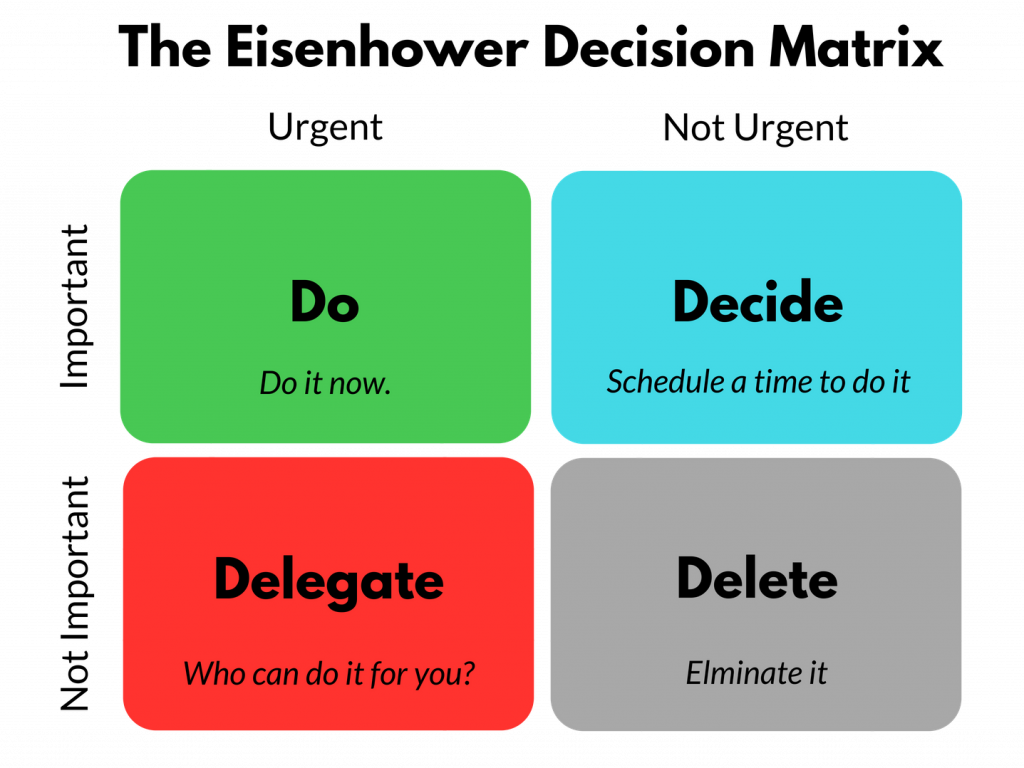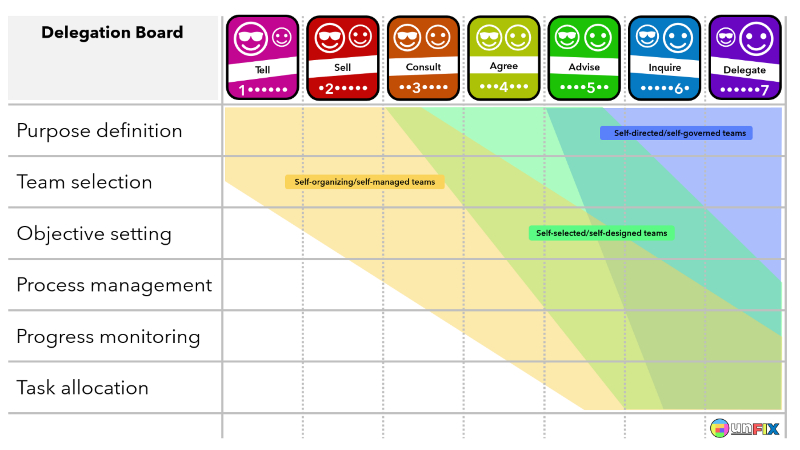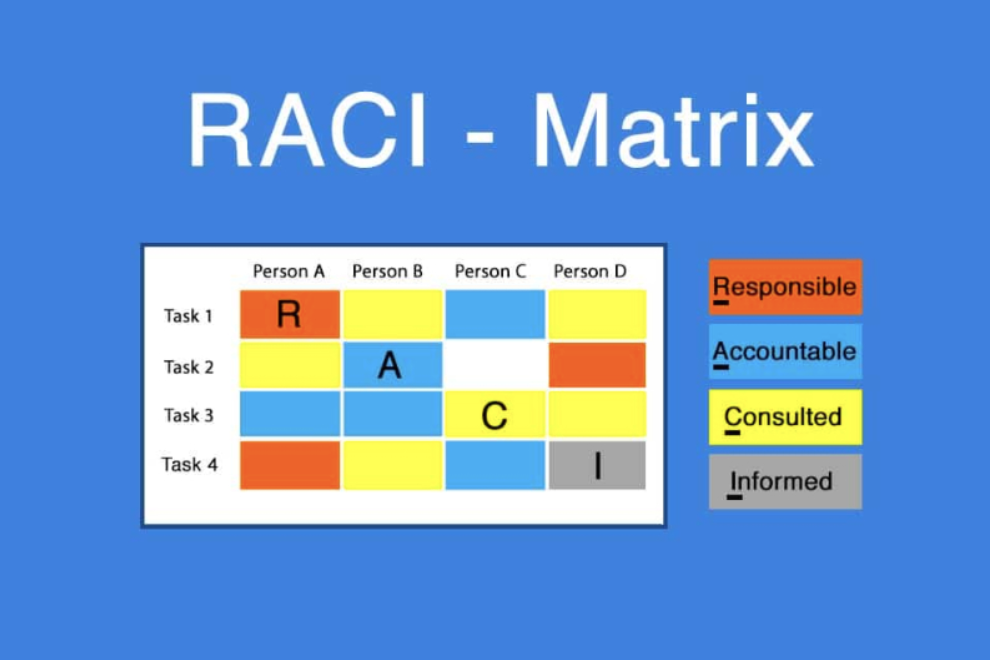Only 30% of leaders believe they can delegate tasks and empower their employees effectively, and only 1/3 of their subordinates recognize them as good delegation leaders. This means that out of 10 leaders, only one actually knows how to delegate effectively, according to a study by John Hunt, a Professor at the London School of Economics.
So how can we improve these numbers? Let’s learn about some methods that Scrum teams apply to the issues of task delegation and empowerment!
Eisenhower Decision Matrix
Named after the 34th President of the United States, Dwight D. Eisenhower, the Eisenhower matrix helps prioritize tasks according to their urgency and importance. Applying this method is actually quite simple. List the tasks that need to be done, and then categorize them into four levels:
- Urgent and important: tasks that need to be done immediately
- Important but not urgent: tasks that can be planned to be done later
- Urgent but not important: tasks that can be delegated to others
- Neither urgent nor important: tasks that can be eliminated to not take resources away from other tasks.

One of the greatest things about the Eisenhower matrix is that it can be applied at both the individual and business levels, as well as any project scale. By prioritizing tasks, Eisenhower not only helps manage time more effectively but also helps us identify which tasks can be delegated to others.
There are 7 levels of delegation and 7 steps to effective task delegation.
According to the Agile spirit, work belongs to the team and results or issues that arise are also the team’s responsibility. However, if all responsibility is concentrated within the team, it can lead to overlapping work. The Delegation Board – a board that assigns tasks according to 7 levels of delegation – will help leaders/team members identify the tasks and authority of each team member, in order to delegate tasks to the “right person for the right job”.

The seven levels of empowerment include:
#1. Tell – I will tell them: At this level, the leader makes a decision and informs the employee without any discussion.
#2. Sell – I will try and sell it to them: The leader explains the decision to the employee, and the employee feels involved in the decision-making process.
#3. Consult – I will consult and then decide: The leader consults with the employee to consider the information before making a decision.
#4. Agree – We will agree together: The leader discusses with everyone, and the team agrees on the final decision.
#5. Advise – I will advise but they decide: The leader expresses their personal opinion, but the final decision is up to the employee.
#6. Inquire – I will enquire after they decide: The employee makes their own decision and reports back to the leader.
#7. Delegate – I will fully delegate: The decision-making authority lies with the employee, who only needs to report their decision to the leader if requested.
The seven steps of task delegation include:
#1. Clearly define the task.
#2. Discuss the purpose of the task.
#3. Clearly define expected results.
#4. Provide resources.
#5. Communication channels and mechanisms.
#6. Regular two-way feedback.
#7. Accept the results.
RACI Matrix
In addition to the Delegation Board, the RACI matrix is also a tool to help manage tasks and effectively delegate authority to members.

R – Responsible: The person directly responsible for carrying out the task.
A – Accountable: The person responsible for explaining the task.
C – Consulted: The person consulted for advice on the task.
I – Informed: The person who is informed about the results of the task.
What should be noted when assigning tasks according to the RACI matrix?
- Ensure balance so that one person does not have too many “R” roles and another person has too few.
- Update the RACI matrix when there are changes in personnel, customer requirements, and passing through different sprints.
- The matrix is based on discussions and agreements of the entire team.
So how are task delegation and authority granted in a Scrum team?
In essence, a Scrum team is a self-managing and cross-functional team. Through tools and Sprint events, each member of the team has a clear picture of their responsibilities. They know what to do at each stage of the project.
All things considered, the role of the Scrum Master is very important. This is a servant-leader style of leadership, responsible for ensuring the smooth operation of the entire Scrum team. With the above task delegation and authority-granting methods, We hoped that the Scrum Master will be able to apply them effectively in their work.
How to use these tools together:
The Eisenhower Decision Matrix, Delegation Board, and RACI Matrix are all powerful tools that can help you prioritize tasks, delegate responsibilities, and clarify roles and responsibilities within a team. Here’s how you can use them together:
Start by using the Eisenhower Decision Matrix to prioritize your tasks. This matrix helps you categorize tasks into four quadrants based on their importance and urgency. Once you have identified the tasks that are most important and urgent, you can move on to the next step.
Next, use the Delegation Board to identify which tasks can be delegated to others. The Delegation Board is a visual tool that helps you identify who is responsible for each task, who needs to be informed, and who needs to be consulted. By delegating tasks to others, you can free up your own time to focus on the tasks that are most important and urgent.
Finally, use the RACI Matrix to clarify roles and responsibilities within your team.Then Use RACI matrix to identify who is responsible for each task, who is accountable for ensuring that the task is completed, who needs to be consulted, and who needs to be informed. This will help ensure that everyone knows what they need to do and that tasks are completed efficiently and effectively.
By using these three tools together, you can prioritize your tasks, delegate responsibilities, and clarify roles and responsibilities within your team. This can help you and your team work more efficiently and effectively, and ensure that you are making the most of your time and resources.
Read related article: Learn about Burn down chart – Progress management tool in Scrum
